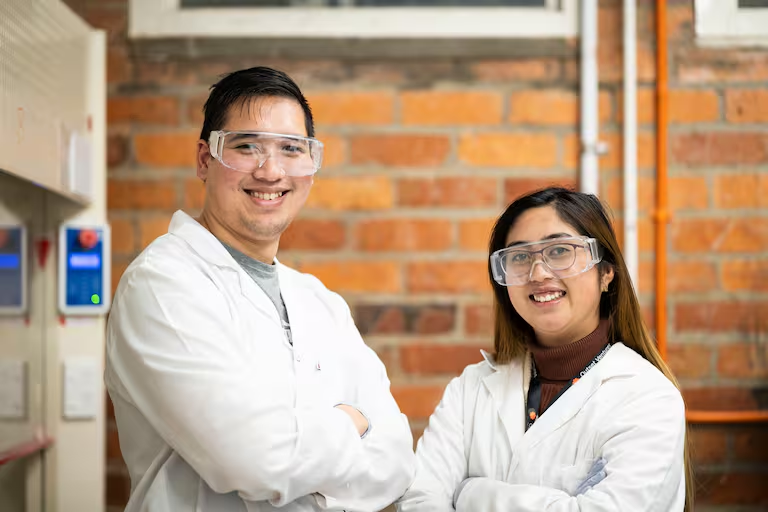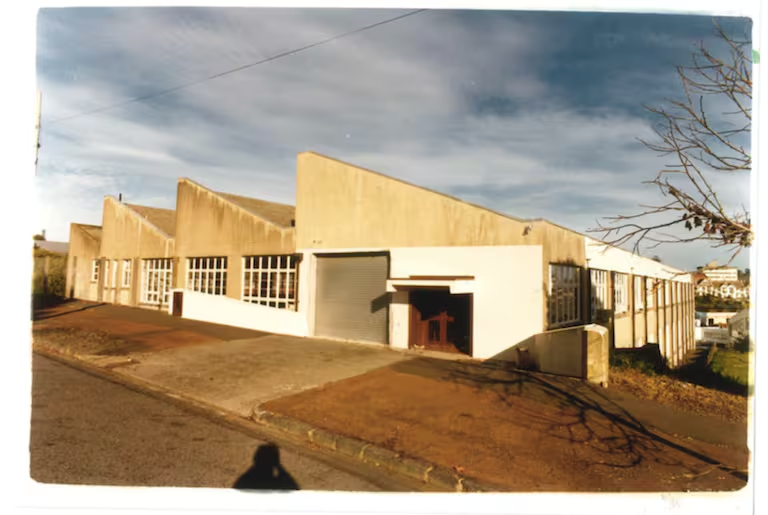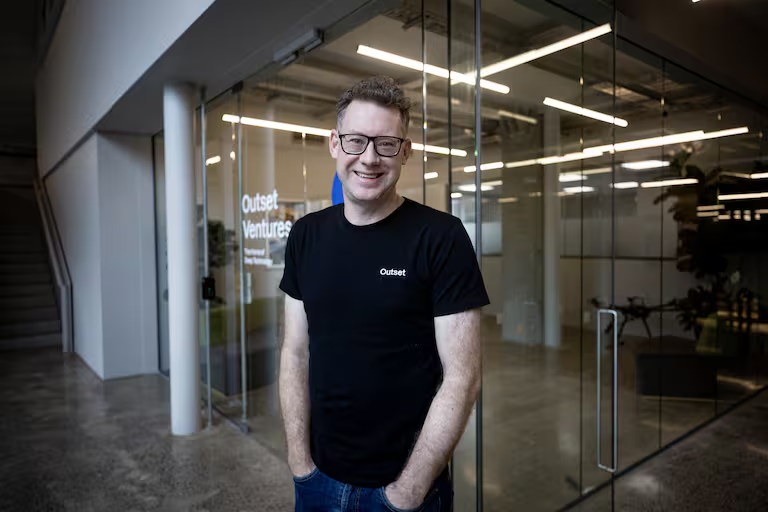


Tucked away in Auckland’s Parnell are some of New Zealand’s biggest scientific and engineering brains, turning the seemingly impossible into a reality. Jane Phare visits the deep-tech world of Future House.
Auckland engineer Anvil Banez grew up watching his father Dennis struggling to walk after polio attacked his body at the age of 1, leaving his left leg wasted and supported by a cumbersome brace.
Despite his disability, Dennis Banez became a powerlifting champion and started his own gym. Inspired by his father’s achievements, Anvil Banez decided that, one way or another, he would develop technology that would help people like his father to walk unaided, simply by wearing a pair of pants.
He formed Dennisson Technologies, named after his father, to develop technology called AuraFlex, essentially an artificial muscle powered by light. Every day Banez, a former mechanical engineer with the Royal New Zealand Air Force, works in a laboratory with staff, including his wife and co-founder Kimberley who has a background in chemistry, slowly making progress.

Mechanical engineer Anvil Banez and his wife Kimberley who co-founded Dennisson Technologies.
Dennisson Technologies is one of an impressive list of start-ups and well-on-the-way companies based in Auckland’s Future House, thought to be the country’s only privately funded deep-tech and science facility.
When the boffins who work at Future House go home at night, it’s very likely the average IQ of the inner-city suburb of Parnell plummets. Among the scientists, engineers, entrepreneurs, inventors and deep-tech experts are 60 PhDs, plus other impressive degrees and big brains exploding with ideas and cleverness.
Future House is where Sir Peter Beck of Rocket Lab and Dr Sean Simpson, co-founder of LanzaTech – both listed on US stock exchange the Nasdaq – started in small work spaces, figuring out how to send rockets into space and how to recycle carbon, envisioning a future when aircraft are powered by recycled greenhouse gas emissions.

Future House, then known as Brooke House, is where Rocket Lab founder and CEO Sir Peter Beck worked on the idea of sending rockets into space. Photo / Dean Purcell
It’s a place where smart people with smart deep-tech ideas can move from their garage or rented container into a small research space or a ready-to-go laboratory set up with compressed air, three-phase power and fume extraction.
A tour of the building leaves lesser brains grappling to understand the technology behind much of the innovation, and how any of it could possibly work.
Stroll the corridors and visitors will see vegan leather made from mushrooms/fungi; a sustainable liquid energy; low-carbon concrete made without using cement; and an engineering process that means spirits like whisky and rum can be processed in days, not months or years.
Future House, tucked away in a quiet, leafy suburban street, started life in the 1950s as a wool store and was later taken over by government agency the Department of Scientific and Industrial Research (DSIR) which morphed into Industrial Research Ltd.

Future House in Parnell, now a deep-tech facility, started life in the 1950s as a wool store.
Back in 2006 the building, then called Brooke House, came on the market. Enter Phillimore Properties, owned by brothers Ross and Ken Healy, and Terry Gould, known for buying heritage buildings with good bones and converting them to lucrative office space.
They’d already had success using that formula with the Textile Centre in Parnell, and the Imperial Buildings which run between Auckland’s Queen St and Fort Lane, converting them to elegant, uber-cool spaces attractive to tenants.
Gould and co planned to do the same with the 9500sq m building, blessed with soaring five-metre tall concrete studs and plenty of light. Industrial Research decided to remain in half of the building as tenants so Phillimore’s makeover plans were put on hold.
The start-up tenants it housed worked happily from the Parnell base until 2017 when Industrial Research, which had morphed into Crown entity Callaghan Innovation in 2013, relocated to the Textile Centre, also home to venture capital firm Icehouse Ventures.
Nowhere to go
That left some of the start-ups, scientists and engineers who had been incubated by Callaghan more or less stranded with nowhere to go.
Mat Rowe, who was once in charge of research and development at Lanza Tech, knew the facility was too valuable to the deep-tech community to see it converted to swanky office space. Where else would start-ups get access to laboratory space outside universities and institutions?
He put a proposal to Gould, suggesting a sort of partnership with the goal of creating a state-of-the-art centre for innovation. In hindsight, Gould admits it probably wasn’t one of Phillimore’s most commercial decisions. Start-ups and smart inventors who have moved out of their garages into research spaces and labs may not be the best rent payers. As they say in the industry, in deep-tech terms an overnight success is 10 years.
Add to that the cost of a massive renovation by bespoke architects Fearon Hay, started during Covid and finished last year, and the numbers don’t really add up. Gould thinks the makeover of Future House, renamed in 2022, cost in the region of $30 million and before that were what he calls the tenant “subsidy” years. But now, he says happily, Future House is a commercial enterprise.

Future House in Parnell underwent a $30 million makeover and refit, designed by architects Fearon Hay. Photo / Dean Purcell
Half the building is leased by deep-tech incubator Outset Ventures, of which Rowe is a co-founder, which supports start-ups and, in some cases, invests in them through its Outset Ventures Fund.
During the Covid years, Rowe and his partners raised money from high net-worth individuals, institutions and even wealthy foreigners sheltering in New Zealand to help fund deep-tech start-ups.
They invest not just in Kiwi companies working from the Parnell base but projects throughout New Zealand involving energy, industrial chemistry, future food, biotechnology, aerospace, med-tech and materials.
They include fusion energy company OpenStar Technologies and portable MRI company Wellumio, both in Wellington, emission-reduction company Aspiring Materials in Christchurch and EV charger company Kwetta (formerly Red Phase) in Hawke’s Bay.
Rowe lives and breathes the innovation and startling deep-tech results emerging from within Future House. At the same time, he understands the commercial relationship with Phillimore and so do his tenants.
“They [his start-up tenants] pay me rent, I pay Terry [Gould] rent.”

Mat Rowe of Outset Ventures, which is based at Future House in Parnell, is a hub for deep-tech, engineering, bio-med, AI, science, entrepreneurs and inventors in modern R&D laboratories owned by Terry Gould of Phillimore Properties. Photo / Dean Purcell
Half the building is leased by deep-tech incubator Outset Ventures, of which Rowe is a co-founder, which supports start-ups and, in some cases, invests in them through its Outset Ventures Fund.
During the Covid years, Rowe and his partners raised money from high net-worth individuals, institutions and even wealthy foreigners sheltering in New Zealand to help fund deep-tech start-ups.
They invest not just in Kiwi companies working from the Parnell base but projects throughout New Zealand involving energy, industrial chemistry, future food, biotechnology, aerospace, med-tech and materials.
They include fusion energy company OpenStar Technologies and portable MRI company Wellumio, both in Wellington, emission-reduction company Aspiring Materials in Christchurch and EV charger company Kwetta (formerly Red Phase) in Hawke’s Bay.
Rowe lives and breathes the innovation and startling deep-tech results emerging from within Future House. At the same time, he understands the commercial relationship with Phillimore and so do his tenants.
“They [his start-up tenants] pay me rent, I pay Terry [Gould] rent.”
Rowe and Outset Ventures partner Mike Bignell know exactly what’s going on behind the lab doors and research spaces. They can rattle off the specifics of each project, what it hopes to achieve and how it will get there.
Tenants range from one person working on a project to more mature companies like Ruminant Bio Tech which is developing methane-inhibiting bolus (reducing methane from cow burps and farts). Ruminant moved a team into Future House this year after raising equity of $12.2m to accelerate growth.
Bignell says the focus of the Outset Ventures Fund is deep scientific and technical risk but limited market risk.
“So if you can help someone get to a point where they can create cheaper energy, you don’t need to worry about how you sell it. The market is obvious, it will just be taken up.”
EnergyBank is one of the Future House tenants in which the Outset fund has invested, plus Icehouse Ventures and Blackbird Ventures.
The company is developing technology to store offshore wind power in underwater batteries. Take Mingyang’s Smart Energy massive 20-megawatt offshore wind turbine installed this year in Hainan, China, this year, Rowe says. The output will be huge, enough to power 96,000 homes annually.
The base cable won’t take all the load at peak times so off-shore storage is needed, which is where the technology developed by EnergyBank comes in.
The fund has also supported Dennison Technologies in its development of an artificial human muscle.
When the Herald visits, mechatronics engineer Scott Wilson, head of product for Dennisson, produces what looks like a thin strip of lightweight rubbery material. It looks like it would snap from a sharp tug but is strong enough to lift 250 times its weight.
Wilson doesn’t try to explain exactly how it works; instead we don goggles to protect our eyes from the bright LED light, he switches on a tiny power source to work the light, and the artificial “muscle” slowly contracts inside a sheath.
“There’s quite advanced chemistry going on that makes it do that shrinkage,” Wilson says.
The fabric muscle, made from polymer layers, can contract by 30%, more than equal to a human muscle.
In the short term the company is talking to sports companies, working with a former lead scientist for Nike – think of a compression bra to support big-breasted women when they are exercising – medical companies, automotive industries and even Nasa for space applications.
In the longer term, CEO Anvil Banez wants to invent a pair of quiet, slim-line pants to help his dad, and others, move their limbs – not a bulky, heavy version powered by a noisy motor.
Deep-tech founders return
As we tour the building, the stories and deep-tech links that are now part of Future House’s history keep coming. Both Rocket Lab and LanzaTech founders have come full circle.
The companies’ founders are back. Beck is a general partner in the Outset Ventures Fund and on its investment committee, and sits on the board of some of the Future House companies. Simpson is now the chair of Outset Ventures and has co-founded Ternary Kinetics, based at Future House, which has developed a sustainable liquid energy source that can be stored, pumped and shipped.
Beck is also involved with Ternary Kinetics, as is Sean Molloy, co-founder of climate-tech company Avertana, which refines industrial waste, such as titanium-bearing slag, into valuable mineral and chemical products.
Avertana, based in Future House, now has commercial deals lined up with Chinese steel mills.
“We’re talking piles of waste that are the size of city blocks,” Rowe says.
In another funding round, Outset Ventures put $450,000 behind Reactory, engineering technology that means spirits like rum, whisky or gin can be processed in days, not months or years.
Founder Mark Eltom went from experimenting using a one-litre tank in his garage, scaling up to 40 litres at Future House and has now shipped a 5000-litre “reactory” to Paraguay in South America. This month Eltom travelled to Jamaica, not to sell rum to the Caribbean but the technology to process the rum faster.
Likewise the founders of Neocrete, which produces concrete using low-carbon materials like volcanic ash instead of cement, were working from a container in a backyard before moving to new labs at Future House. Now they’ve raised $6.5m from Singaporean-based fund Wavemaker Partners to invest in a manufacturing plant.
Ag-tech company Bio Telliga, developing organic crop protection, has just had a multimillion-dollar fundraising round. The lab set-ups don’t come cheap. Outset Ventures spent $250,000 fitting one 100sq m containment laboratory, and Bio Telliga has spent the same in a second laboratory.
On what Rowe jokes is the “anti-cow floor” is Daisy Lab which is producing cow-less dairy products using genetically modified yeast and precision fermentation, a process akin to brewing. The protein is dairy-identical and can be scaled up, with potentially the ability to feed millions who can’t afford protein.
Nearby is Sapro-Tech, another company that moved from a garage, where scientists are creating vegan material identical in feel, looks and strength to leather.
The space at Future House is like a deep-tech revolving door – doctorates and the resulting successful companies move out, another moves in, upgraded from a garage or rented container.
Among the Future House success stories that have outgrown their Parnell home and moved on is e-waste recycler Mint Innovation which is going global. The company opened an e-waste plant in Sydney in 2022 and has another planned in Texas.
An empty space vacated by deep-tech start-up Aquila, which has relocated to Australia, is in the process of being painted ready for the next tenant. Aquila uses lasers to move energy around, essentially using laser beams to wirelessly charge drones while in flight. It was an idea scaled up from an idea on a piece of paper to keep a drone in flight “pretty much until it falls apart”, Rowe says.
And the future? Powering aircraft and eventually wires in space between satellites for moving power around, effectively terrestrial and extraterrestrial power movement.
Spaces aren’t empty for long, Rowe says. Future House and its community draws others – engineers, scientists and deep-tech inventors – to it, as well as international visitors and potential investors. This month a group from TU Delft faculty of aerospace engineering from the Netherlands visited on a study tour.
The building’s top floor is a vast shared space where newcomers can network, exchange ideas, seek help, share hot-desks, relax together and where people with PhDs can take turns to empty the dishwasher in the state-of-the-art kitchen.
One wall is covered with tiny polaroid photos, a type of honours board celebrating those who have either been through Future House or are still in residence.
On this floor are small, ready-to-go labs that newcomers can rent for a month with no bond.
The importance of Future House as a privately run and funded lab and engineering facility cannot be underestimated, Rowe says.
“It’s very rare and very necessary for our economic development. Probably over two or three billion dollars in value have come out of this building since Lanza Tech and Rocket Lab started.”
Auckland Council has given a small sponsorship of $50,000 to help incubate four companies at Future House. One start-up is working on ways to make kānuka honey as successful as mānuka. Another is developing a system that will heat hot water when power is cheapest and turn it off when it’s not; and heat the water to 65 degrees at free or cheap times so it can drop back down afterwards. A third start-up is developing a form of floating concrete to be used for piers and wharves. The fourth $50,000 sponsorship has been held for an upcoming project.
Gould looks justifiably proud as we tour the building. He doesn’t understand half of what’s going on behind the lab doors but he knows it’s important. He and his business partners have got behind the “Kiwi number eight wire” mentality.
Backing Future House has been a long and expensive journey he says, but is now a commercial venture.
“People in the commercial property world would probably look at us and think that we’re crazy.”
But Gould doesn’t regret effectively subsidising Outset Ventures and Future House’s other tenants in the early days.
“To actually remove that from this environment would have been criminal.”
Jane Phare is a senior Auckland-based business, features and investigations journalist, former assistant editor of NZ Herald and former editor of the Weekend Herald and Viva.
